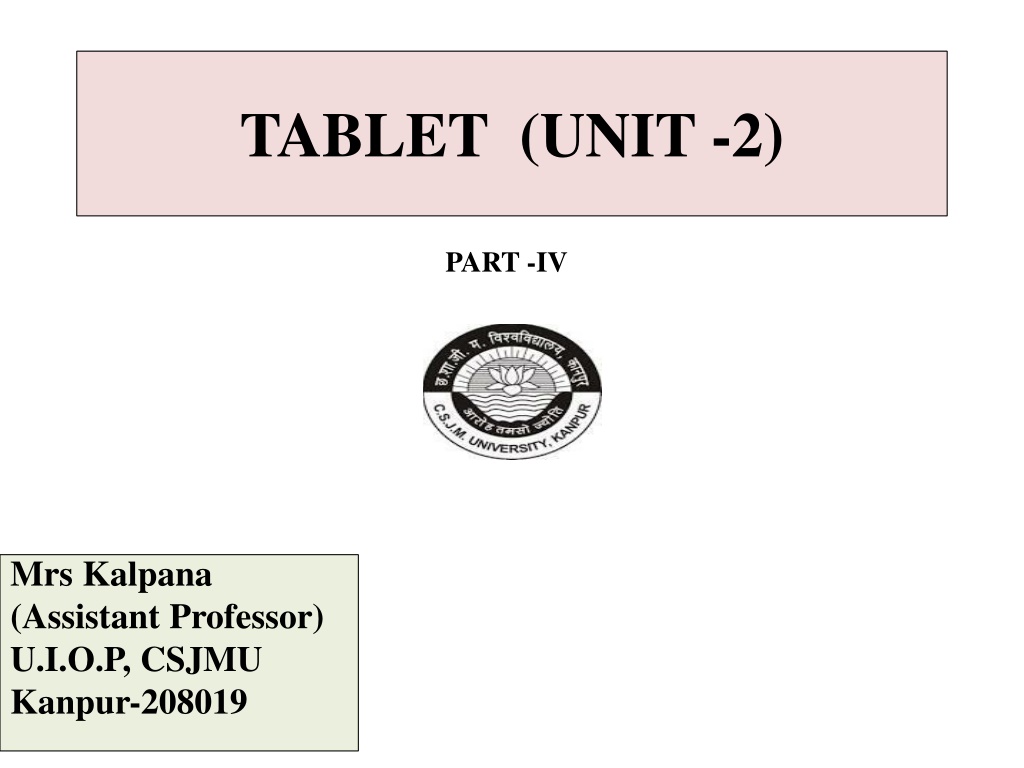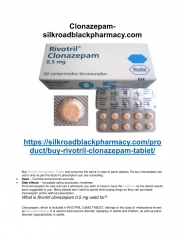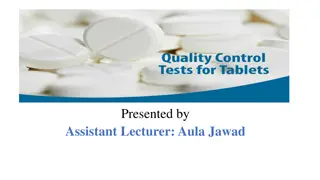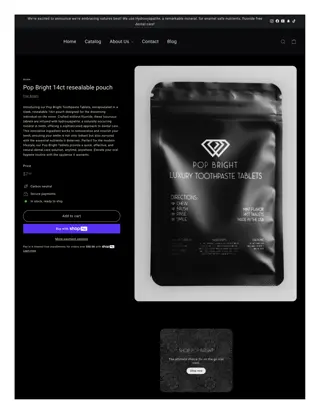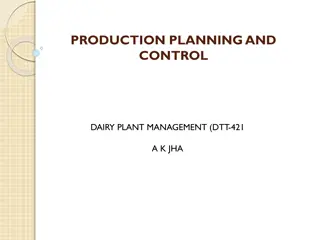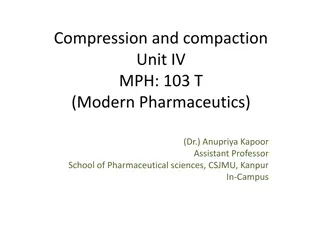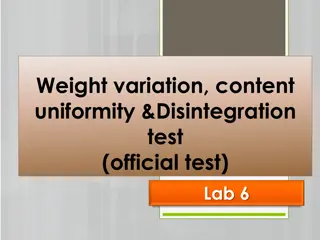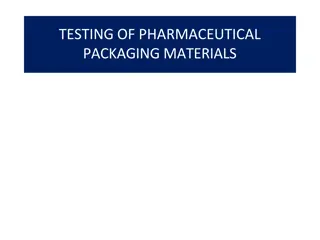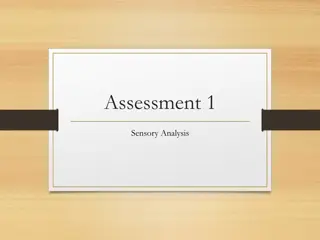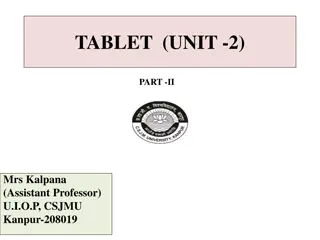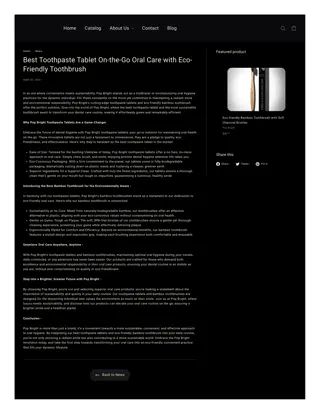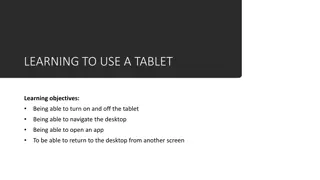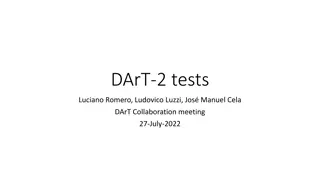Quality Control Tests for Tablet Production
Quality control tests play a crucial role in ensuring the safety and efficacy of tablet products. This article discusses various parameters like general appearance, size, shape, unique identification markings, organoleptic properties, hardness, friability, weight variation, and content uniformity that are evaluated to maintain the quality of tablets during production. Methods such as measuring tablet thickness, checking for color distribution and uniformity, testing hardness and friability, performing weight variation tests, and conducting disintegration tests are essential steps in the quality control process.
Download Presentation

Please find below an Image/Link to download the presentation.
The content on the website is provided AS IS for your information and personal use only. It may not be sold, licensed, or shared on other websites without obtaining consent from the author.If you encounter any issues during the download, it is possible that the publisher has removed the file from their server.
You are allowed to download the files provided on this website for personal or commercial use, subject to the condition that they are used lawfully. All files are the property of their respective owners.
The content on the website is provided AS IS for your information and personal use only. It may not be sold, licensed, or shared on other websites without obtaining consent from the author.
E N D
Presentation Transcript
TABLET (UNIT -2) PART -IV Mrs Kalpana (Assistant Professor) U.I.O.P, CSJMU Kanpur-208019
Quality Control Test of Final Product OR Evaluation of Tablet General Appearance: The general appearance of a tablet involves its identity, general elegance which is essential for consumer acceptance, tablet-to-tablet uniformity and for control of lot-to-lot uniformity The control of general appearance involves the measurement of shape, size,, presence or absence of odor, color. taste etc Size & Shape: It can be dimensionally described and controlled. The thickness of a tablet is also a variables. Micrometer is used to measure the thickness of tablet. Tablet thickness should be controlled within a 5% variation of standard value.
Unique identification marking These marking involves the type of embossing, engraving or printing. These markings usually include dose, product code, company name or symbol name etc. Organoleptic properties Involves colour , odour ,taste. Color distribution should be uniform with no mottling. For visual color comparison compare the color of sample against standard color. Hardness Tablet should have certain amount of strength , hardness and resistance to friability i.e. should be able to withstand mechanical shocks during handling in manufacture, packaging and shipping. Hardness generally measures the tablet crushing strength.
Friability It can be determine in laboratory by using Roche friabilator. It consist of a plastic chamber that revolves at 25 rpm and dropping the tablets from a distance of six inches in the friabilator, It is operated for 100 revolutions. The tablets are reweighed. The friability % range should be between 0.5 to 1.0 % .
Weight Variation test (U.S.P.) Take 20 tablet and weighed individually. Calculate average weight and compare the individual tablet weight to the average. The tablet pass the U.S.P. test if no more that 2 tablets are outside the percentage limit and if no tablet differs by more than 2 times the percentage limit. Content Uniformity Test: Randomly 30 tablets are selected.10 tablets assayed individually. The Tablet pass the test if 9 of the 10 tablets must contain not less than 85% and not more than 115% of the labeled drug content and the 10th tablet may not contain less than 75% and more than <125% of the labeled content. If these conditions are not met, remaining 20 tablet assayed individually and none may fall out side of the 85 to 115% range .
Disintegration Test (U.S.P.) The U.S.P. device to test disintegration uses 6 glass tubes that are 3 long; open at the top and 10 mesh screen at the bottom end. To test for disintegration time, one tablet is placed in each tube and the basket rack is positioned in a 1-L beaker of water, simulated gastric fluid or simulated intestinal fluid at 37 2 0 C such that the tablet remain 2.5 cm below the surface of liquid on their upward movement and not closer than 2.5 cm from the bottom of the beaker in their downward movement. Move the basket containing the tablets up and down through a distance of 5-6 cm at a frequency of 28 to 32 cycles per minute. Floating of the tablets can be prevented by placing perforated plastic discs on each tablet
According to the test the tablet must disintegrate and all particles must pass through the 10 mesh screen in the time specified. If any residue remains, it must have a soft mass. Disintegration time: Uncoated tablet: 5-30 minutes Coated tablet: 1-2 hours.
Dissolution Test (U.S.P.) Apparatus-1: A single tablet is placed in a small wire mesh basket attached to the bottom of the shaft connected to a variable speed motor. The basket is immersed in a dissolution medium (as specified in monograph) contained in a 100 ml flask. The flask is cylindrical with a hemispherical bottom. The flask is maintained at 37 0.5 0 C by a constant temperature bath. The motor is adjusted to turn at the specified speed and sample of the fluid are withdrawn at intervals to determine the amount of drug in solutions.
Apparatus-2: It is same as apparatus-1, except the basket is replaced by a paddle. The dosage form is allowed to sink to the bottom of the flask before stirring. For dissolution test U.S.P. specifies the dissolution test medium and volume, type of apparatus to be used, rpm of the shaft, time limit of the test and assay procedure for. The test tolerance is expressed as a % of the labeled amount of drug dissolved in the time limit.
